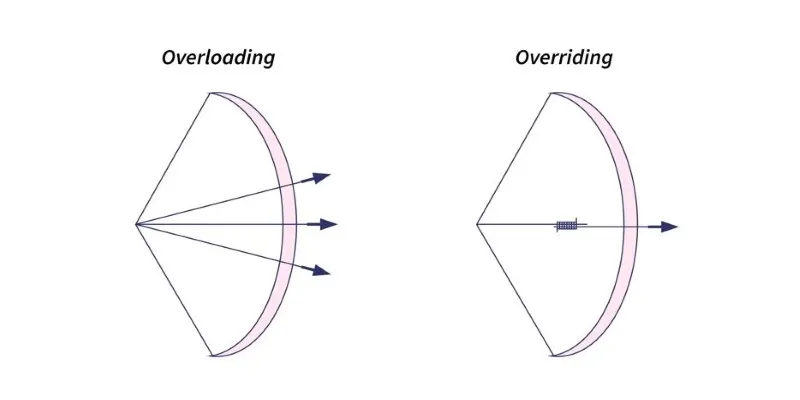In object-oriented programming, understanding the concepts of method overloading and method overriding is crucial. Although these terms may sound similar, they serve different purposes in programming. Method overloading allows multiple methods with the same name but different parameters within a class. In contrast, method overriding lets subclasses modify the behavior of inherited methods.
Grasping the difference between method overloading and overriding helps you write cleaner, more flexible, and maintainable code. These concepts are not just academic—they are practical tools that significantly influence class design, code reuse, and overall programming efficiency.
Understanding Method Overloading
Method overloading occurs when you define multiple methods in the same class with the same name but different parameters. The variations may include the number of arguments, data types, or the sequence of parameters. Overloading is not about changing behavior but about enabling a method to handle various inputs effectively.
Imagine method overloading as a Swiss Army knife—one tool with many uses. Each version of the method is designed for different inputs, such as handling two integers, a string and a float, or no input at all. The method name remains constant, but the compiler selects the appropriate one at compile-time based on the arguments, demonstrating compile-time polymorphism.
Languages like Java, C++, and C# provide strong support for method overloading. While Python lacks native overloading, developers often use default parameters or argument inspection to achieve similar functionality.
The primary benefit of method overloading is clarity. Instead of creating new method names for each input variation, you reuse a single, consistent name. However, poorly structured overloading can lead to confusing code if methods perform similar tasks but return unclear results. When used correctly, it streamlines development and maintains clean interfaces.
Understanding Method Overriding
Method overriding occurs when a subclass defines a method with the same name, return type, and parameters as a method in its superclass. This allows the subclass to provide its version of the method, altering the behavior defined by the parent class. Unlike overloading, which focuses on multiple versions of a method in the same class, overriding is used across inheritance hierarchies, enabling runtime polymorphism.

When you call a method on a superclass reference pointing to a subclass
object, the overridden method in the subclass executes. This mechanism, called
runtime polymorphism, enables dynamic behavior, allowing objects to decide
which version of a method to use at runtime. For instance, a base class Animal
with a speak() method can be overridden by Dog and Cat subclasses to provide
their specific implementations.
Overriding is powerful but requires careful usage. The overridden method must
exactly match the parent’s method signature. Many languages use annotations
(like @Override in Java) to make this explicit. While it promotes
extensibility, it can also add complexity. When done correctly, it supports
flexible, future-ready code; if mishandled, it can lead to fragile class
hierarchies.
Key Differences and How They Impact Code Design
The core difference between method overloading and overriding lies in context, timing, and intention. Overloading happens within a single class, while overriding occurs across a class hierarchy. Overloading is resolved at compile-time, whereas overriding is settled at runtime. Overloading adds variety to method calls, while overriding changes the method’s actual behavior.
If you’re building a utility or helper class, method overloading might be your first choice. It simplifies and unifies interfaces, such as a logging function that can accept strings, objects, or exceptions. Conversely, if you’re working with class hierarchies or designing extensible systems, method overriding is the preferred tool. It allows specific behaviors to be plugged into a general structure.
Intent is another crucial factor. Method overloading often enhances developer experience by making APIs or classes appear smarter and more flexible. Method overriding, meanwhile, provides fundamental control, tailoring shared behavior to specific scenarios.
Both techniques have pitfalls. Method overloading can confuse developers if not implemented clearly, especially when too many variations obscure each method’s purpose. Reckless use of method overriding can result in fragile hierarchies, where changes in a base class unpredictably affect subclasses. Modern programming often favors composition over inheritance in complex scenarios.
Despite their differences, overloading and overriding often coexist. A base class method might be overridden in child classes, and within each class, you might overload it to handle specific data types or contexts. Mastering when to use one, the other, or both together is essential in object-oriented programming.
Practical Scenarios and Language-Specific Notes
In Java, method overloading is commonly used in constructors. For instance,
one constructor might accept only a name, while another accepts both name and
age, providing flexible object creation. Java also extensively uses method
overriding, especially in frameworks like Android, where onCreate() is
overridden to initialize specific behaviors.

C++ follows similar patterns, with overloading handled by the compiler at compile-time. Overriding uses virtual functions; forgetting the virtual keyword prevents the method from behaving polymorphically.
Python easily allows method overriding by redefining methods in subclasses but
lacks built-in support for overloading. Developers simulate overloading using
default parameters, *args, **kwargs, or the singledispatch module.
Each language offers a unique approach, but the distinction between method overloading and overriding remains consistent. Developers must choose based on the problem at hand, the language’s features, and the need for clarity and maintainability.
Conclusion
Understanding the difference between method overloading and overriding is vital for writing clear, effective object-oriented code. Overloading enhances flexibility within a class, while overriding empowers subclasses to customize inherited behavior. One operates at compile-time, the other at runtime—both are essential tools for scalable design. By using them wisely, you can build software that’s easier to read, extend, and maintain. Knowing when and how to apply each technique lays the foundation for writing smarter, more adaptable code in any language.
 zfn9
zfn9






















